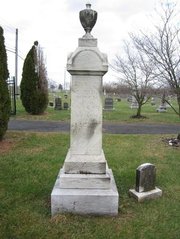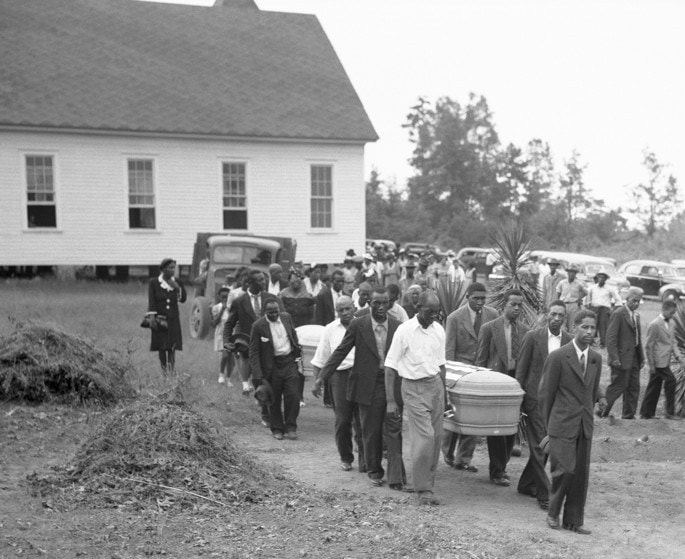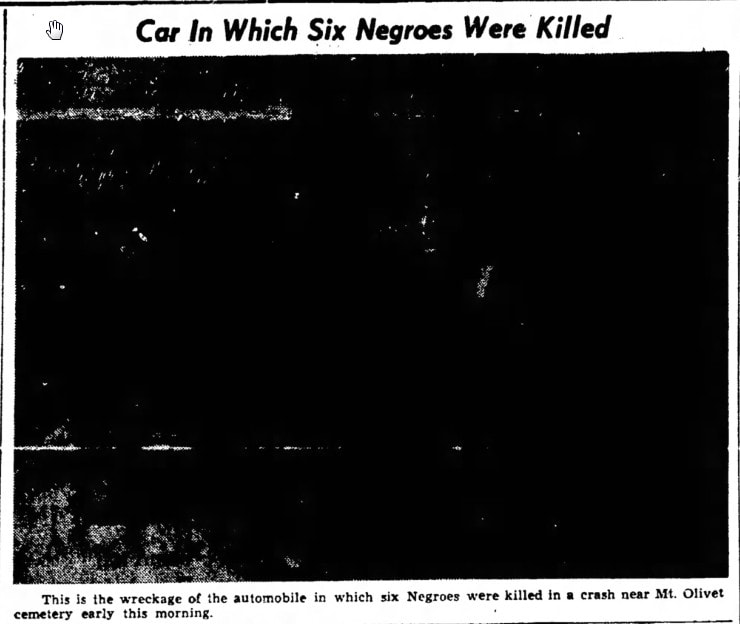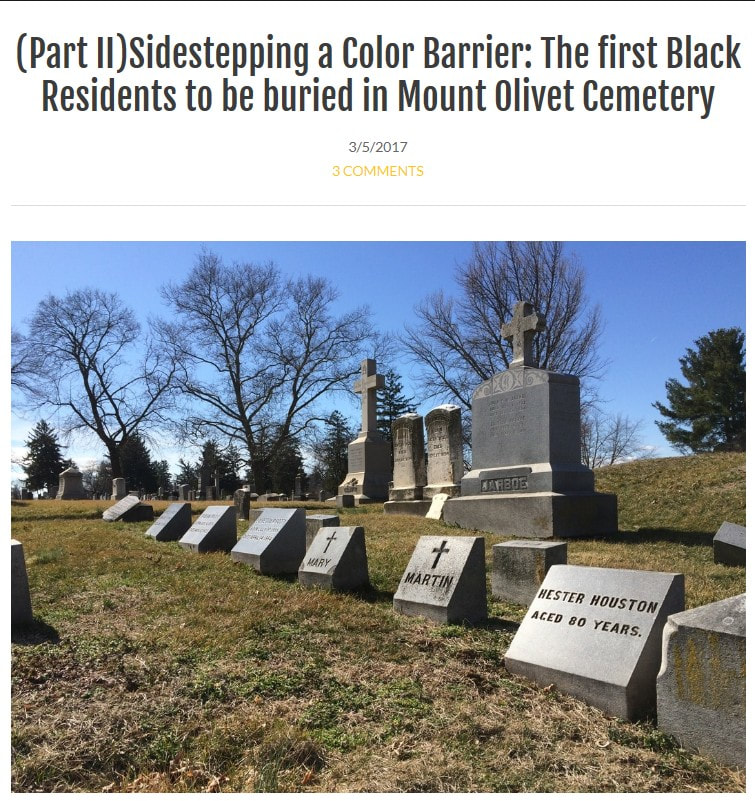 Grave of Dr. U.G. Bourne, Sr. in Fairview Cemetery Grave of Dr. U.G. Bourne, Sr. in Fairview Cemetery As February is quickly coming to a close, I was interested to see if I could tie-in topic relating to Black History Month. Some of you may recall the three-part series we featured (on this blog) last year at this time entitled: Sidestepping a Color Barrier: The first Black residents to be buried in Mount Olivet Cemetery. Yes, Mount Olivet, like so many institutions here in Frederick, was segregated up through the Civil Rights Movement. Although, I had a pretty good understanding of the genesis and evolution of Frederick’s “separate but equal” burying grounds, there is so much more to be gleaned by reading primary source materials of old to attempt to interpret or explain history. Of particular interest to me was the rise of Fairview Cemetery on Gas House Pike, which quickly filled the void left by the sale of W. 7th Street’s Greenmount Cemetery to the City Hospital (today’s Frederick Memorial Hospital) in the second decade of the 20th century. Fairview is the final resting place of Dr. U.G. Bourne, Sr., Frederick’s first Black physician and NAACP founder—a man who did so much over his lifetime to change mindsets and perceptions. Other Black history luminaries resting here include William O. Lee, Esther Grinage, John W. Bruner and Charles Brooks. As far as Greenmount, it was the predominant burying ground for Black residents of Frederick up until the time of its sale—if you will, it was “the Black Mount Olivet.” This sizeable cemetery was located on the ground now occupied by FMH’s west parking lot and garage. In reading last year’s series, you will also learn about the former All Saints’ Burying Ground (adjacent Carroll Creek) in the heart of Downtown, and the controversial story of Laboring Sons Cemetery. Much has been written about this latter location, sandwiched between E. 5th and E. 6th streets, employing a good measure of misinformation and embellishment which has caused media sensationalism and unique political posturing over the last two decades. Take it from someone who has thoroughly investigated the subject, the demise of Laboring Sons was self-inflicted by its trustees more than anything else. The most rewarding part of producing the 3-part series came as I tasked myself with finding the first individuals of color to be buried in Mount Olivet. I was pleasantly surprised with some of the revelations that came with discovering individuals such as Maria Harper, Laura Hill, Hester Houston, Abe Brighton, Martha Snowden and Bird Smith. All but Ms. Smith were former slaves, and death to them could have taken on the cultural mantra of “Homegoings.” As with other traditions, practices, customs and norms of Black culture, this ritual for dealing with death was shaped by the African-American experience. Author Sara J. Marsden, editor in chief for US Funerals Online, recently posted a feature on the topic entitled: “Homegoing Funerals: An African American Funeral Tradition.” Here’s an excerpt: The simplest explanation for the term “Homegoing” is that it represents the religious connotation of the deceased “going home,” to heaven and glory, and to be with the Lord. It is a Christian-based service, most commonly held in a chapel or church. The deceased is most commonly buried, after a very elaborate service, as the belief is held that their body will be resurrected. A homegoing funeral is often referred to as a “homegoing celebration” as it is considered to be an uplifting event celebrating the return of the soul to the eternal glory. The heritage of the homegoing funeral ritual has its origins back in Ancient Egypt. The ancient African Egyptian people had a rich culture of preparing for a funeral and preserving the deceased for their “after-life.” This could be noted as the origins of people of color demonstrating elaborate funeral practices. This rich Black heritage was brought to the United States during the era of slavery. During slavery the Black communities were not permitted to gather to conduct their funeral rituals for fear that they would conspire to revolt. Slaves that died were ordinarily just buried without any ceremony in un-marked graves in non-crop producing ground. However, at the same time slaves would be responsible for the preparation of the deceased plantation owner’s family following a death and preparing the elaborate family gatherings held to mourn the deceased. Controlling the repressed slaves and preventing an uprising was an ever-difficult task for the plantation owners, especially as the number of slaves on a plantation could begin to outnumber the plantation owner’s family and managers. So white Christian religion was introduced to the slaves to help pacify and subjugate. Many enslaved Blacks believed death meant their soul would return home to their native Africa. The Old Testament stories of God and Moses freeing a captive and enslaved race resonated with the slaves. The New Testament stories of Jesus and promises of glory in heaven and a far better after-life allowed slaves to forge through the turmoil of mortal life and look forward to the day when they would return home to the Lord. They fully embraced Christianity and death, for slaves, was viewed as freedom. Their death rituals were jubilant and it became one of the earliest forms of African American culture. Anyway, I invite you to partake in last year's 3-part story, you'll find links at the end of this article. Deaths occur within feet of FSK Monument While performing research work last year for the above-mentioned “Stories in Stone,” feature, I came across an especially traumatic and chilling event which occurred at Mount Olivet Cemetery 76 years ago. I found this article innocently enough while plugging word combinations into the search engine for the online Newspapers.com archival site. Among my searches, I eventually typed the words Mount Olivet Cemetery, Frederick, Negro, and death. Sadly I immediately found the following article headline, dated February 23rd, 1942. It appears that a horrific early morning car accident occurred just outside Mount Olivet’s picturesque front gate. Then superintendent Cyril Klein would be the first to see the grisly scene. The driver of a sedan entered town from the south on S. Market Street, going at a rate of 60-70 miles/hour. He lost control while attempting to negotiate the slight bend in the road. This was coupled with a wet road surface. The car subsequently slid 90 feet to the west until slamming into an aged Maple tree—one planted around the turn of the 20th century in front of the Superintendent's House and outside of the cemetery’s fence (fronting on S. Market Street). The reckless driving of an inexperienced driver was blamed for triggering the crash. Only one of the passengers was a Frederick City resident, hailing from nearby Phebus Avenue, roughly six blocks from the accident scene. This was 18 year-old Gabriela M. Moore. It was thought that the group was solely in town to bring Gabriela home. Unfortunately for the young lady and her friends, there would be six “homegoings” and only one homecoming. Six out of the seven occupants in the ill-fated sedan perished as a result of this tragic event—most expiring on impact. The driver was 17 and the others in the car ranged from 22-14 years of age. A lone survivor, Mildred E. Sewell of New Market, would spend the next month in the hospital, but would make a full recovery. I would eventually come across a better copy of the article from a scrapbook. This clearly shows the vehicle involved in this tragic accident. Up to that time, this was the single, deadliest automobile accident in Frederick County’s history. I venture to guess that it remains the worst in Frederick City history, and among the worst in county history. All in all, I was somewhat taken aback by the graphic level of reporting for this story, which also included a photo of the smashed-up automobile, but I couldn’t quite make it out clearly from the newspaper copy I had found. Nationwide, north and south, it was not uncommon in the late 1800’s and early 1900’s for newspapers to include reports of odd and awful accidents and deaths befalling Blacks and immigrants. I have included the initial report of this accident appearing in the February 23rd edition of the Frederick News. I still find the description of injuries a bit too much, especially in respect to an era with a backdrop of the Second World War. Frederick’s Gabriela Moore was laid to rest in Gas House Pike’s Fairview Cemetery on Wednesday, February 25th. A triple funeral would be held in Damascus, and others took place in New Market and Fountain Mills near Kemptown. Burying grounds are no strangers to victims of automobile accidents. Within Mount Olivet, there are hundreds. However, anyone would find it puzzling, and moreso ironic, to learn that a cemetery had played a contributing role in the deaths of six young people. So very sad.. Click any of the above icons to read more.
6 Comments
Joe Fitzgerald
2/25/2018 07:07:02 am
The headstone for Gabriela appears to be misdated....1941 instead of 1942?
Reply
Chris Haugh
2/26/2018 08:47:05 pm
Yes, I noticed that too, not to mention that Gabriela's middle initial should be an M. And not an N. Must have been placed many years later.
Reply
Irene Packer-Halsey
2/25/2018 12:28:10 pm
Your articles always fascinate me. This so sad.
Reply
Lorraine Blakeslee
2/25/2018 05:28:33 pm
Could you please identify the cemetery behind the current Heslth Dept. I was under the impression that was s Black cemetery or was it a general pauper testing ground
Reply
Chris Haugh
2/26/2018 08:57:07 pm
The burying ground at Montevue was a puaper's cemetery, referred to as Potter's Field. And Montevue was the area's second almshouse, Home to indigent, and needy folks. I have also seen references to "the Institutional Cemetery," and as others think this was downtown (either another name for Laboring Sons or adjacent Laboring Sons) I seem to believe this to be another name for the Montevue cemetery since Montevue, was in fact, an institution, itself.
Reply
Leave a Reply. |
STORIES
|
Archives
July 2024
June 2024
May 2024
April 2024
March 2024
February 2024
January 2024
December 2023
November 2023
September 2023
August 2023
July 2023
June 2023
May 2023
April 2023
March 2023
February 2023
January 2023
December 2022
November 2022
October 2022
September 2022
August 2022
July 2022
June 2022
May 2022
April 2022
March 2022
February 2022
January 2022
December 2021
November 2021
October 2021
September 2021
August 2021
July 2021
June 2021
May 2021
April 2021
March 2021
February 2021
January 2021
December 2020
November 2020
October 2020
September 2020
August 2020
July 2020
June 2020
May 2020
April 2020
March 2020
February 2020
January 2020
December 2019
November 2019
October 2019
September 2019
August 2019
July 2019
June 2019
May 2019
April 2019
March 2019
February 2019
January 2019
December 2018
November 2018
October 2018
September 2018
August 2018
July 2018
June 2018
May 2018
April 2018
March 2018
February 2018
January 2018
December 2017
November 2017
October 2017
September 2017
August 2017
July 2017
June 2017
May 2017
April 2017
March 2017
February 2017
January 2017
December 2016
November 2016























 RSS Feed
RSS Feed